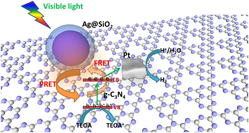Crossref Citations
This article has been cited by the following publications. This list is generated based on data provided by
Crossref.
Chen, Jianan
Yu, Miao
Wang, Yuhao
Shen, Shaohua
Wang, Meng
and
Guo, Liejin
2014.
Au@SiO2 core/shell nanoparticle-decorated TiO2 nanorod arrays for enhanced photoelectrochemical water splitting.
Chinese Science Bulletin,
Vol. 59,
Issue. 18,
p.
2191.
Lü, Xiaomeng
Shen, Jiayu
Wu, Ziwei
Wang, Jiaxi
and
Xie, Jimin
2014.
Deposition of Ag nanoparticles on g-C3N4nanosheet byN,N-dimethylformamide: Soft synthesis and enhanced photocatalytic activity.
Journal of Materials Research,
Vol. 29,
Issue. 18,
p.
2170.
Leong, Kah Hon
Liu, Sze Ling
Sim, Lan Ching
Saravanan, Pichiah
Jang, Min
and
Ibrahim, Shaliza
2015.
Surface reconstruction of titania with g-C3N4 and Ag for promoting efficient electrons migration and enhanced visible light photocatalysis.
Applied Surface Science,
Vol. 358,
Issue. ,
p.
370.
Wang, Xixi
Chen, Jie
Guan, Xiangjiu
and
Guo, Liejin
2015.
Enhanced efficiency and stability for visible light driven water splitting hydrogen production over Cd 0.5 Zn 0.5 S/g-C 3 N 4 composite photocatalyst.
International Journal of Hydrogen Energy,
Vol. 40,
Issue. 24,
p.
7546.
Chen, Jie
Dong, Chung‐Li
Du, Yuanchang
Zhao, Daming
and
Shen, Shaohua
2015.
Nanogap Engineered Plasmon‐Enhancement in Photocatalytic Solar Hydrogen Conversion.
Advanced Materials Interfaces,
Vol. 2,
Issue. 14,
Cao, Shaowen
Low, Jingxiang
Yu, Jiaguo
and
Jaroniec, Mietek
2015.
Polymeric Photocatalysts Based on Graphitic Carbon Nitride.
Advanced Materials,
Vol. 27,
Issue. 13,
p.
2150.
Li, Chunquan
Sun, Zhiming
Liu, Lixin
Huang, Weixin
and
Zheng, Shuilin
2016.
Facile synthesis and enhanced visible-light photoactivity of a g-C3N4/mullite composite.
RSC Advances,
Vol. 6,
Issue. 93,
p.
91002.
Xie, Lihong
Ai, Zhuyu
Zhang, Meng
Sun, Runze
Zhao, Weirong
and
Mishra, Yogendra Kumar
2016.
Enhanced Hydrogen Evolution in the Presence of Plasmonic Au-Photo-Sensitized g-C3N4 with an Extended Absorption Spectrum from 460 to 640 nm.
PLOS ONE,
Vol. 11,
Issue. 8,
p.
e0161397.
Fu, Shurong
He, Yiming
Wu, Qi
Wu, Ying
and
Wu, Tinghua
2016.
Visible-light responsive plasmonic Ag2O/Ag/g-C3N4 nanosheets with enhanced photocatalytic degradation of Rhodamine B.
Journal of Materials Research,
Vol. 31,
Issue. 15,
p.
2252.
Shen, Shaohua
Zhao, Daming
Chen, Jie
Guo, Liejin
and
Mao, Samuel S.
2016.
Enhanced photocatalytic hydrogen evolution over graphitic carbon nitride modified with Ti-activated mesoporous silica.
Applied Catalysis A: General,
Vol. 521,
Issue. ,
p.
111.
Li, HongWei
Zhu, Hekai
Wang, Meng
Min, Xin
Fang, Minghao
Huang, Zhaohui
Liu, Yan’gai
and
Wu, Xiaowen
2017.
A new Ag/Bi7Ta3O18 plasmonic photocatalyst with a visible-light-driven photocatalytic activity.
Journal of Materials Research,
Vol. 32,
Issue. 19,
p.
3650.
García-Mendoza, Cinthia
Oros-Ruiz, Socorro
Ramírez-Rave, Sandra
Morales-Mendoza, Getsemani
López, Rosendo
and
Gómez, Ricardo
2017.
Synthesis of Bi2S3nanorods supported on ZrO2semiconductor as an efficient photocatalyst for hydrogen production under UV and visible light.
Journal of Chemical Technology & Biotechnology,
Vol. 92,
Issue. 7,
p.
1503.
Li, Hao
Jing, Yue
Ma, Xinlong
Liu, Tongyao
Yang, Linfeng
Liu, Bin
Yin, Shu
Wei, Yongzhi
and
Wang, Yuhua
2017.
Construction of a well-dispersed Ag/graphene-like g-C3N4photocatalyst and enhanced visible light photocatalytic activity.
RSC Advances,
Vol. 7,
Issue. 14,
p.
8688.
Ni, Zilin
Zhang, Wendong
Jiang, Guangming
Wang, Xiaoping
Lu, Zhenzhen
Sun, Yanjuan
Li, Xinwei
Zhang, Yuxin
and
Dong, Fan
2017.
Enhanced plasmonic photocatalysis by SiO 2 @Bi microspheres with hot-electron transportation channels via Bi–O–Si linkages.
Chinese Journal of Catalysis,
Vol. 38,
Issue. 7,
p.
1174.
Chen, Yuxin
Lu, Wangyang
Wang, Xiyi
and
Chen, Wenxing
2018.
Graphitic carbon nitride embedded in hot-melt adhesive polyester and hydrophilic cellulose blend fibers for the efficient elimination of antibiotics under solar irradiation.
Applied Surface Science,
Vol. 453,
Issue. ,
p.
110.
Patnaik, Sulagna
Sahoo, Dipti Prava
and
Parida, Kulamani
2018.
An overview on Ag modified g-C3N4 based nanostructured materials for energy and environmental applications.
Renewable and Sustainable Energy Reviews,
Vol. 82,
Issue. ,
p.
1297.
Wang, Mengjun
Liu, Chao
Zhang, Xiaobo
Fan, Zichun
Xu, Jiasheng
and
Tong, Zhiwei
2018.
In situ synthesis of CsTi2NbO7@g-C3N4 core–shell heterojunction with excellent electrocatalytic performance for the detection of nitrite.
Journal of Materials Research,
Vol. 33,
Issue. 23,
p.
3936.
Lu, Luhua
Lv, Zaozao
Si, Yanjie
Liu, Muye
and
Zhang, Si
2018.
Recent progress on band and surface engineering of graphitic carbon nitride for artificial photosynthesis.
Applied Surface Science,
Vol. 462,
Issue. ,
p.
693.
Zhang, Fan
Wang, Liping
Xiao, Mei
Liu, Fei
Xu, Xia
and
Du, Erdeng
2018.
Construction of direct solid-state Z-scheme g-C3N4/BiOI with improved photocatalytic activity for microcystin-LR degradation.
Journal of Materials Research,
Vol. 33,
Issue. 2,
p.
201.
Patwari, Jayita
Chatterjee, Arka
Sardar, Samim
Lemmens, Peter
and
Pal, Samir Kumar
2018.
Ultrafast dynamics in co-sensitized photocatalysts under visible and NIR light irradiation.
Physical Chemistry Chemical Physics,
Vol. 20,
Issue. 15,
p.
10418.



